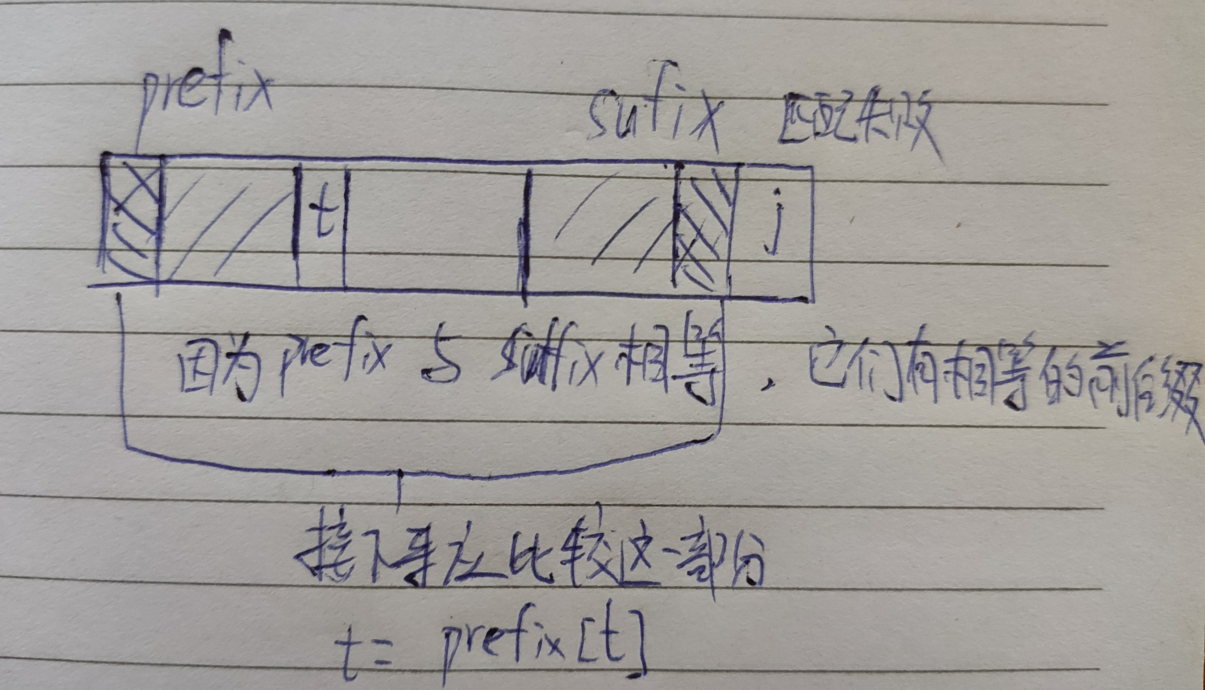推荐 B 站一个 UP 的视频,讲的非常容易理解 链接
暴力匹配思路 设模式串为 sp,要匹配的目标字符串为 st
扫一遍 st,每次从 st 当前位置开始匹配 sp,这样做浪费了大量时间,之前匹配过程得到信息没有被有效利用。
KMP 算法 最大公共前后缀 KMP 中为了有效利用之前已获得的信息,使用了最大公共前后缀。
KMP 算法流程 构造最大前后缀数组 首先构造 presuf 数组,构造的流程如下
为了方便算法编写,令 presuf[0] = -1 作为边界,最大公共前后缀从 1 下标开始记录。
1 2 3 4 5 6 7 8 9 t = presuf[0] = -1 m = sp.length() while j < m-1 // 当前位置前后缀匹配,更新 presuf 数组 if t < 0 || sp[j] == sp[t] presuf[++j] = ++ t // 当前不匹配,则应该缩小前缀的范围 else t = presuf[t];
匹配流程 1 2 3 4 5 6 7 8 9 10 11 i = 0 j = 0 m = st.length() while j < m if i < 0 || sp[i] == st[i] ++i,++j if i == sp.length() // 得到结果 else // 这一步也很好理解,和构造过程是一样 i = presuf[i]
代码实现 为了便于理解,变量名都是用了更具意义的缩写
1 2 3 4 5 6 7 8 9 10 11 12 13 14 15 16 17 18 19 20 21 22 23 24 25 26 27 28 29 30 31 32 33 34 35 36 37 38 39 40 41 42 43 44 #include <bits/stdc++.h> using namespace std;const int maxn = 10005 ;int main () string st = "AAAAAAAAB" ; string sp = "AAAAB" ; int presuf[maxn]; memset (presuf, 0 , sizeof int prep = presuf[0 ] = -1 ; int sufp = 0 ; while (sufp < sp.size ()) { if (prep < 0 || sp[prep] == sp[sufp]) { presuf[++sufp] = ++prep; } else { prep = presuf[prep]; } } int stp = 0 , spp = 0 ; int res = -1 ; while (stp < st.size ()) { if (spp < 0 || st[stp] == sp[spp]) { ++spp, ++stp; if (spp == sp.length ()) { res = stp; break ; } } else { spp = presuf[spp]; } } cout << res; }
应用 KMP 算法的应用,判定一棵二叉树是否是另一颗二叉树的子树,如果这棵树的序列化字符串是另一棵树序列化字符串的子串,则可以判定。
